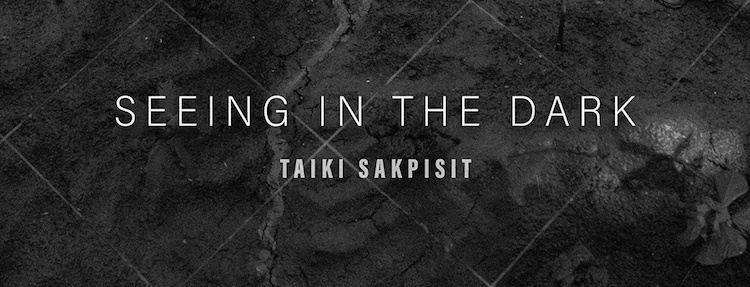
Taiki Sakpisit’s exhibition Seeing in the Dark opened at AC Gallery in Bangkok on 14th December and closes today. The exhibition includes regular screenings of Taiki’s video installation of the same name, which was filmed at Khao Kho, a mountainous region in northern Thailand. Khao Kho has a potent political legacy: Phibun Songkhram hid the country’s gold reserve — and the Emerald Buddha statue — from the Japanese there during World War II, and the area was a base for communist insurgents throughout the 1970s.
Seeing in the Dark opens with contemplative, static images of Khao Kho, including the entrance to the cave where Phibun stored the nation’s treasures. There are also shots of the Sacrificial Monument compound, which memorialises the ‘sacrifices’ of the soldiers who fought the communists, rather than the thousands of insurgents who were killed. Taiki’s earlier short films Shadow and Act and A Ripe Volcano (ภูเขาไฟพิโรธ) feature similarly meditative shots of locations with loaded political histories, and Shadow and Act has a direct link with Phibun, as it was partially filmed at the photography studio where his official portraits were taken. Shadow and Act, A Ripe Volcano, and The Age of Anxiety (รอ ๑๐) will be screened at the Thai Film Archive on Christmas Eve as part of the 25th Thai Short Film and Video Festival (เทศกาลภาพยนตร์สั้น ครั้งที่ 25).
On its website, Thailand’s Ministry of Tourism notes that Khao Kho was once “a red area smoldering in the smoke of war from different political ideologies. Khao Kho was considered a forbidden land that ordinary people should not get too close to because it was considered extremely dangerous. But as time passed, the conflict ended and Khao Kho transformed into one of Phetchabun’s most striking and beautiful tourist areas.” A similar reputational whitewashing took place at other sites of anti-communist violence, such as Santikhiri and Nabua, a process examined in Thunska Pansittivorakul’s film Santikhiri Sonata (สันติคีรี โซนาตา), Apichatpong Weerasethakul’s short film A Letter to Uncle Boonmee (จดหมายถงลงบญม), and Pachara Piyasongsoot’s exhibition Anatomy of Silence (กายวิภาคของความเงียบ).
Khao Kho, Santikhiri, and Nabua are — to use Dutch artist Armando’s term — ‘guilty landscapes’. Seeing in the Dark revisits these ‘guilty landscapes’, tranquil spaces that bear silent witness to historical violence. As Max Crosbie-Jones writes in his cover story for the current issue of Art Review Asia, Taiki’s film channels “the presence of places upon which the inexorable movement of Thai history has left an indelible stain.” An ominous rumble on the soundtrack hints at the continued presence of this past menace, and the film ends with footage of anti-government protests from October 2020, a reminder that Thailand is still “smoldering in the smoke of war from different political ideologies.”
Seeing in the Dark opens with contemplative, static images of Khao Kho, including the entrance to the cave where Phibun stored the nation’s treasures. There are also shots of the Sacrificial Monument compound, which memorialises the ‘sacrifices’ of the soldiers who fought the communists, rather than the thousands of insurgents who were killed. Taiki’s earlier short films Shadow and Act and A Ripe Volcano (ภูเขาไฟพิโรธ) feature similarly meditative shots of locations with loaded political histories, and Shadow and Act has a direct link with Phibun, as it was partially filmed at the photography studio where his official portraits were taken. Shadow and Act, A Ripe Volcano, and The Age of Anxiety (รอ ๑๐) will be screened at the Thai Film Archive on Christmas Eve as part of the 25th Thai Short Film and Video Festival (เทศกาลภาพยนตร์สั้น ครั้งที่ 25).
On its website, Thailand’s Ministry of Tourism notes that Khao Kho was once “a red area smoldering in the smoke of war from different political ideologies. Khao Kho was considered a forbidden land that ordinary people should not get too close to because it was considered extremely dangerous. But as time passed, the conflict ended and Khao Kho transformed into one of Phetchabun’s most striking and beautiful tourist areas.” A similar reputational whitewashing took place at other sites of anti-communist violence, such as Santikhiri and Nabua, a process examined in Thunska Pansittivorakul’s film Santikhiri Sonata (สันติคีรี โซนาตา), Apichatpong Weerasethakul’s short film A Letter to Uncle Boonmee (จดหมายถงลงบญม), and Pachara Piyasongsoot’s exhibition Anatomy of Silence (กายวิภาคของความเงียบ).
Khao Kho, Santikhiri, and Nabua are — to use Dutch artist Armando’s term — ‘guilty landscapes’. Seeing in the Dark revisits these ‘guilty landscapes’, tranquil spaces that bear silent witness to historical violence. As Max Crosbie-Jones writes in his cover story for the current issue of Art Review Asia, Taiki’s film channels “the presence of places upon which the inexorable movement of Thai history has left an indelible stain.” An ominous rumble on the soundtrack hints at the continued presence of this past menace, and the film ends with footage of anti-government protests from October 2020, a reminder that Thailand is still “smoldering in the smoke of war from different political ideologies.”

